Wikipedia:Picture of the day/January 2019
|
Featured picture tools: |
These featured pictures, as scheduled below, appeared as the picture of the day (POTD) on the English Wikipedia's Main Page in January 2019. Individual sections for each day on this page can be linked to with the day number as the anchor name (e.g. [[Wikipedia:Picture of the day/January 2019#1]] for January 1).
You can add an automatically updating POTD template to your user page using {{Pic of the day}} (version with blurb) or {{POTD}} (version without blurb). For instructions on how to make custom POTD layouts, see Wikipedia:Picture of the day.Purge server cache
January 1

|
The Garden at Sainte-Adresse is an oil-on-canvas painting by the French impressionist painter, Claude Monet. It was painted in 1867 in the French resort town of Sainte-Adresse, where Monet was spending the summer. The models were probably Monet's father Adolphe, his cousin Jeanne Marguerite Lecadre, her father Adolphe Lecadre, and perhaps Lecadre's other daughter, Sophie, the woman seated with her back to the viewer. The painting is composed with flat horizontal bands of colour, which were reminiscent of Japanese colour wood-block prints. The Garden at Sainte-Adresse is now in the Metropolitan Museum of Art in New York City. Painting: Claude Monet
Recently featured:
|
January 2

|
The blue petrel (Halobaena caerulea) is a small seabird in the family Procellariidae, the only member of its genus. It is distributed across the Southern Ocean but breeds at only six known sites, all close to the Antarctic Convergence zone. Its plumage is predominantly blue-grey, with an "M" banding across its top, which is similar to that of the closely-related prion. It also has a white-tipped tail. The blue petrel is 28 cm (11 in) in length with a wing span of 66 cm (26 in), and feeds predominantly on krill as well as other crustaceans, fish, and squid. Photograph: JJ Harrison
Recently featured:
|
January 3

|
Médée is a French-language opera by the composer Luigi Cherubini. Set in the ancient city of Corinth, Greece, it features a libretto by François-Benoît Hoffman and is based on Euripides's tragic play Medea and Pierre Corneille's play Médée. The opera premiered in 1797 at the Théâtre Feydeau in Paris. The long-lost final aria, which Cherubini appears to have deleted from his original manuscript, was discovered by researchers from the University of Manchester and Stanford University by employing X-ray techniques to reveal areas that the composer had blackened out. This picture shows the title page for a vocal score of the 1909 hybrid version of Médée. Graphic: Giuseppe Palanti
Recently featured:
|
January 4
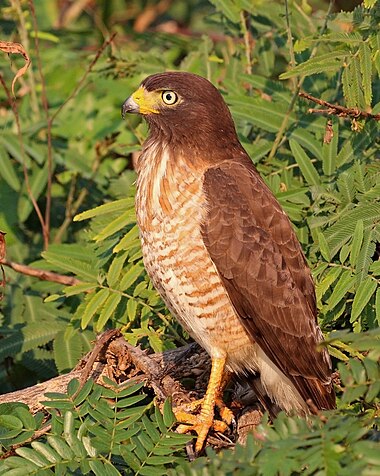
|
The roadside hawk (Rupornis magnirostris) is a relatively small bird of prey found in the Americas. A vocal species, it is often the most common raptor in its range. It has many subspecies, and although previously placed in the genus Buteo, it is now usually placed in the monotypic genus Rupornis. The roadside hawk is 31–41 cm (12–16 in) long and weighs 250–300 g (8.8–10.6 oz). Males are about 20% smaller than females, but otherwise the sexes are similar. This picture shows an immature roadside hawk in the Pantanal, Brazil. Photograph: Charles J. Sharp
Recently featured:
|
January 5

|
The Torment of Saint Anthony is the earliest known painting by the Italian artist Michelangelo, painted in around 1487–1488 when he was only 12 or 13 years old. A copy of The Temptation of St Anthony, an engraving by Martin Schongauer, it shows Saint Anthony being assailed in the desert by demons, whose temptations he resisted. This was a common medieval subject, included in the Golden Legend and other sources, although this composition shows a later episode where St Anthony, normally flown about the desert supported by angels, was ambushed in mid-air by devils. The Torment of Saint Anthony is in the permanent collection of the Kimbell Art Museum in Fort Worth, Texas. Painting: Michelangelo
Recently featured:
|
January 6

|
The Larsen Ice Shelf is a long ice shelf in the Weddell Sea, extending along the east coast of the Antarctic Peninsula. It is named after Norwegian explorer Carl Anton Larsen, who sailed along the ice front in 1893. Composed of a series of shelves along the coast, named with letters from A to G, since the mid-1990s the Larsen Ice Shelf has been disintegrating, with the collapse of Larsen B in 2002 being particularly dramatic. A large section of the Larsen C shelf broke away in July 2017 to form an iceberg known as A-68. The area of the whole Larsen Ice Shelf was formerly 33,000 square miles (85,000 km2), but today is only 26,000 square miles (67,000 km2). Photograph: NASA/John Sonntag
Recently featured:
|
January 7

|
Christmas in Serbia is celebrated on 25 December in the Julian calendar, which currently corresponds to 7 January in the Gregorian calendar. The Serbian name for Christmas is Božić, which is the diminutive form of the word bog ("god"), and can be translated as "young god". Christmas is celebrated for three consecutive days, starting with Christmas Day, which the Serbs call the first day of Christmas. On these days, one is to greet another person by saying "Christ is Born," which should be responded to with "Truly He is Born". This picture shows a typical Serbian Christmas meal with grilled pork, Olivier salad (also called Russian salad), dzadziki salad, red wine and Bajadera sweets. Photograph: Petar Milošević
Recently featured:
|
January 8
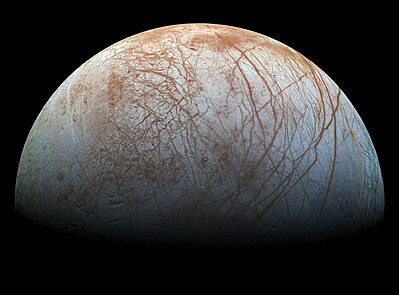
|
Realistic-color mosaic of images of Jupiter's moon Europa taken by NASA's Jupiter orbiter Galileo in 1995 and 1998. This view of the moon's anti-Jovian hemisphere shows numerous lineae, linear features created via a tectonic process in which crustal plates of water ice floating on a subsurface ocean (kept warm by tidal flexing) shift in relative position. Reddish regions are areas where the ice has a higher mineral content. The north polar region is at right. (Geologic features are annotated in Commons.)
Recently featured:
|
January 9

|
Paxillus involutus, the common roll-rim, is a fungus widely distributed across the Northern Hemisphere; it has also been unintentionally introduced to Australia, New Zealand, and South America. The brownish fruit body grows up to 6 cm (2.4 in) high. It has a funnel-shaped cap up to 12 cm (5 in) wide with a distinctive in-rolled rim and decurrent gills close to the stalk. Genetic testing suggests that the fungus may be a species complex rather than a single species. A common mushroom of deciduous and coniferous woods and grassy areas in late summer and autumn, P. involutus is symbiotic with the roots of many tree species, reducing the trees' intake of heavy metals and increasing their resistance to pathogens. Previously considered edible and eaten widely in Eastern and Central Europe, the mushroom has been found to be dangerously poisonous; in 1944, it killed the German mycologist Julius Schäffer. It can trigger the immune system to attack red blood cells with potentially fatal complications, including acute renal and respiratory failure. Photograph: Petar Milošević
Recently featured:
|
January 10

|
|
The Headless Horseman is a mythical figure who has appeared in folklore around the world since at least the Middle Ages. Depending on the legend, the Horseman is either carrying his head, or missing it altogether, and is searching for it. Examples include the dullahan from Ireland, who is a demonic fairy usually depicted riding a horse and carrying his head under his arm; the titular knight from the English tale Gawain and the Green Knight; and "The Legend of Sleepy Hollow," a short story written in 1820 by American Washington Irving which has been adapted into several other works of literature and film including the 1999 Tim Burton movie Sleepy Hollow. This picture, titled The Headless Horseman Pursuing Ichabod Crane, is an 1858 painting by American artist John Quidor, depicting a scene from "The Legend of Sleepy Hollow". It is in the collection of the Smithsonian American Art Museum in Washington, D.C. Painting: John Quidor
Recently featured:
|
January 11

|
Charles Catton (1728–1798) was an English painter of coaches, landscapes, animals and figures. Born in Norwich as one of possibly 35 children of his twice-married father, Catton was apprenticed to a London coach painter or carpenter by the name of Maxwell, and studied drawing at the St. Martin's Lane Academy. He became a member of the Society of Artists, and exhibited various pictures in its galleries in 1760–1764. He was a founding member of the Royal Academy and, in 1784, was master of the Worshipful Company of Painter-Stainers. He exhibited at the Academy from its foundation until the year of his death. This picture is a self-portrait of Catton, dating from 1769. Painting: Charles Catton
Recently featured:
|
January 12

|
|
The Carbajal Valley (Spanish: Valle Carbajal) is located in the Fuegian Andes of southern Tierra del Fuego Province, Argentina. It is approximately 20 kilometres (12 mi) long, running west to east between the Alvear mountain range to the north and the Vinciguerra range to the south. Andes summits in the region are generally less than 1,250 metres (4,100 ft) above sea level. Formed during the Last Glacial Maximum, approximately 20,000 years ago, the nearly U-shaped valley floor is now covered with sphagnum peat bogs and poorly drained mires. Photograph: Godot13
Recently featured:
|
January 13

|
The unicorn is a legendary creature that has been described since antiquity as a beast with a single large, pointed, spiraling horn projecting from its forehead. The unicorn was depicted in ancient seals of the Indus Valley civilization and was mentioned by the ancient Greeks in accounts of natural history by various writers, including Ctesias, Strabo, Pliny the Younger, and Aelian. The Bible also mentions an animal, the re'em, which is translated to "unicorn" in some versions. This picture is a fresco titled The gentle and pensive maiden has the power to tame the unicorn, painted by Italian Domenichino in around 1604–1605. It is in the collection of the Palazzo Farnese in Rome. Painting: Domenichino
Recently featured:
|
January 14

|
Gentiana acaulis, also known as the stemless gentian, is a species of flowering plant in the family Gentianaceae. It is native to central and southern Europe, from Spain east to the Balkans, growing in mountainous regions such as the Alps and Pyrenees. It is a perennial plant, growing up to a height of 10 centimetres (3.9 in) tall and forming a "mat" up to 50 centimetres (20 in) wide. The leaves are evergreen, and can be lanceolate, elliptical or obovate. The trumpet-shaped terminal flowers are blue with olive-green spotted longitudinal throats. A depiction of the Gentiana acaulis flower can be seen on the obverse side of the one cent Austrian euro coin. Photograph: Petar Milošević
Recently featured:
|
January 15

|
The Virgin and Child with St. Anne is an oil painting by Leonardo da Vinci depicting Saint Anne, her daughter the Virgin Mary and the infant Jesus. Christ is shown grappling with a sacrificial lamb on the edge of a precipice, symbolizing his Passion. It is likely that the painting was commissioned by King Louis XII of France following the birth of his daughter Claude in 1499, but it was never delivered to him. Leonardo probed into incorporating these figures together through preparatory works including the Burlington House Cartoon, now in the National Gallery, London, and a drawing which resides in the Louvre, Paris. The Virgin and Child with Saint Anne is also in the Louvre. Painting: Leonardo da Vinci
Recently featured:
|
January 16
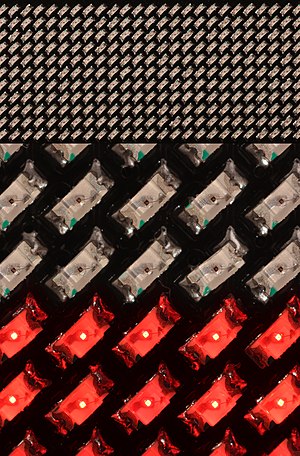
|
A light-emitting diode (LED) is a semiconductor light source that emits light when an electric current flows through it. When a current passes through the diode, which is formed of two different semiconductor materials, electrons are able to recombine with electron holes, releasing energy in the form of photons. This effect is called electroluminescence. The color of the light is determined by the energy required for electrons to cross the band gap of the semiconductor. White light is obtained by using multiple semiconductors or a layer of light-emitting phosphor on the semiconductor device. The earliest practical LEDs, which appeared in 1962, emitted low-intensity infrared and red light. Modern LEDs are available with high output in a range of visible, ultraviolet, and infrared wavelengths. This picture shows three different views of an 11×44 LED matrix lapel name tag display. The top image is of a little over half of the display, the center image is a close-up of the LEDs in ambient light, and the bottom image is the LEDs in their own red light. Photograph: Janke
Recently featured:
|
January 17
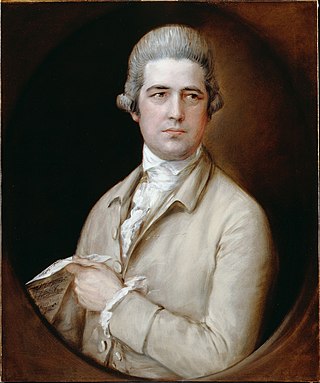
|
Thomas Linley the elder (17 January 1733 – 19 November 1795) was an English bass singer and musician. He began his musical career at age 11 in Bath, becoming apprentice to the organist Thomas Chilcot. Linley married in 1752 and fathered eight children, supporting the family by working as a music teacher. As his children grew he developed their musical talent and was able to draw an increasing amount of income from their concerts. When the Bath Assembly Rooms opened in 1771, Linley became musical director and continued to promote his children's careers. He was eventually able to move to London with the thousands of pounds which he had amassed from their concerts. In addition to his children Linley taught tenor Charles Dignum, singer and actress Anna Maria Crouch, and novelist Frances Sheridan. He collaborated with his son Thomas Linley the younger in penning the comic opera The Duenna, with libretto by his son-in-law Richard Brinsley Sheridan. This picture is an oil-on-canvas painting created around 1770 by Thomas Gainsborough, showing Linley holding his "Elegies for Three Voices". It hangs in the Dulwich Picture Gallery, London. Painting: Thomas Gainsborough
Recently featured:
|
January 18

|
When a liquid drop impacts the surface of a liquid reservoir it can float, bounce, coalesce with the reservoir, or splash. A floating drop remains on the surface for several seconds. Drop bouncing can occur on perturbed liquid surfaces. If the drop is able to rupture the thin film of gas which separates it from the liquid reservoir, it can coalesce. Additionally, higher Weber number drop impacts produce splashing. In the splashing regime, the impacting drop creates a crater in the fluid surface, followed by a crown around the crater. Finally, a central jet, called the "Rayleigh jet" or "Worthington jet", protrudes from the center of the crater. If the impact energy is high enough, the jet rises to the point where it pinches off, sending one or more droplets upward out of the surface. Photograph: José Manuel Suárez
Recently featured:
|
January 19
|
A Trip Down Market Street is a 13-minute actuality film recorded by placing a movie camera on the front of a cable car as it traveled down San Francisco’s Market Street in the spring of 1906. A virtual time capsule from over 100 years ago, the film shows many details of daily life in a major American city, including the transportation, fashions and architecture of the era. The film begins at 8th Street and continues eastward to the cable car turntable, at The Embarcadero, in front of the Ferry Building. Landmarks passed include the Call Building and the Palace Hotel. It was produced by the four Miles Brothers: Harry, Herbert, Earle and Joe. Harry J. Miles cranked the Bell & Howell camera during the filming. The film is notable for capturing San Francisco just before the city's devastating earthquake and fire. Film: Miles Brothers
Recently featured:
|
January 20

|
Lady Standing at a Virginal is a genre painting created by the Dutch artist Johannes Vermeer in about 1670–1672. It is in the permanent collection of the National Gallery, London. The painting depicts a richly dressed woman playing a virginal in a home with a tiled floor, paintings on the wall and some of the locally manufactured Delftware blue and white tiles of a type that appear in other Vermeer works. This work can be related to another Vermeer in the collection, Lady Seated at a Virginal, on a canvas of almost exactly the same size, with which it may form a pair. A recent study has shown that the canvas for the two paintings came from the same bolt. Painting: Johannes Vermeer
Recently featured:
|
January 21

|
The curlew sandpiper (Calidris ferruginea) is a small wader that breeds on the tundra of Arctic Siberia. It is a strongly migratory bird, wintering mainly in Africa, but also in Australia, New Zealand, and south and southeast Asia. The curlew sandpiper is similar to the dunlin, and has a length of 18–23 cm (7.1–9.1 in) and wingspan of 38–41 cm (15–16 in). In breeding season it has a bright red underside. This picture shows a curlew sandpiper in Thailand, with its winter plumage. Photograph: JJ Harrison
Recently featured:
|
January 22

|
Gold certificates were a United States paper currency between 1863 and 1933. Each certificate gave its title to a corresponding amount of gold coin as established by the Coinage Act of 1834. The Series of 1882 was the first series to be payable to the bearer; unlike previous issues, anyone could redeem these certificates for the equivalent in gold. Shown here is a $1000 large denomination banknote, depicting Grover Cleveland. Banknote: Bureau of Engraving and Printing (image courtesy of the National Numismatic Collection, National Museum of American History)
Recently featured:
|
January 23
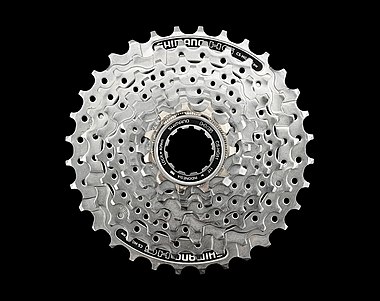
|
Hyperglide is the name given by cycling component manufacturer Shimano to a sprocket design in their bicycle derailleur tooth cassette systems. The design improves on their earlier Uniglide design (which used beveled/twisted gear teeth instead of ramps), and was introduced as part of a commercially viable index shifting system. The individual sprockets on a Hyperglide cassette or freewheel are designed specifically to work with their neighbours. In order to ensure alignment of each sprocket with its neighbour, the freehub has a narrow spline at one position, and each sprocket has a corresponding wide tooth on its inside face. Photograph: Petar Milošević
Recently featured:
|
January 24

|
Gustav III (24 January [O.S. 13 January] 1746 – 29 March 1792) was King of Sweden from 1771 until his assassination in 1792. Born in Stockholm as the eldest son of King Adolf Frederick, he married Sophia Magdalena of Denmark in 1766. At the time of his accession, the Swedish Riksdag held more power than the monarchy but was bitterly divided between rival parties. After unsuccessful attempts to mediate, Gustav seized power himself in 1772, changing the constitution in what is considered a coup d'état. Following an attempt to form a league of princes to counter the French Revolution, a conspiracy formed among Swedish nobles and he was shot while attending the opera. He died two weeks later and was succeeded by his son Gustav Adolf. This picture, titled King Gustav III of Sweden and His Brothers, is a 1771 oil-on-canvas painting by Alexander Roslin. It shows Gustav (seated, left) with his two brothers, Frederick Adolf (standing) and Charles (seated, right). It is now in the Nationalmuseum in Stockholm. Painting: Alexander Roslin
Recently featured:
|
January 25
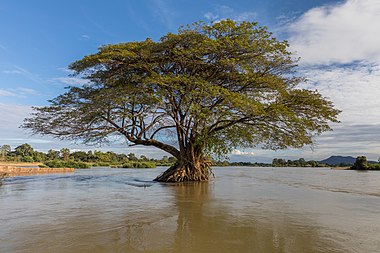
|
Samanea saman, also known as the rain tree or Albizia saman, is a species of flowering tree in the pea family, Fabaceae, that is native to Central and South America. It is a wide-canopied tree with a large umbrella-shaped crown, and usually reaches a height of 15–25 m (49–82 ft) with a diameter of 30 m (98 ft). The tree has pinkish flowers with white and red stamens, set on heads with around 12–25 flowers per head. These heads may number in the thousands, covering the whole tree. Photograph: Basile Morin
Recently featured:
|
January 26

|
The Appearance of Christ Before the People is an oil-on-canvas painting by the Russian painter Alexander Andreyevich Ivanov (1806–1858). It is regarded as his magnum opus and took twenty years to complete, between 1837 and 1857. In the center of the painting John the Baptist, wearing an animal skin, is standing on the banks of the River Jordan. He points towards the figure of Jesus in the distance, approaching the scene. To the left stands the young John the Apostle, behind him St. Peter, and further on Andrew the Apostle and Nathaniel. In the foreground we see people who watch the scene unfold but are undecided what to do, both young and old men. The painting hangs in the Tretyakov Gallery in Moscow. Painting: Alexander Andreyevich Ivanov
Recently featured:
|
January 27

|
Sonar, an acronym for SOund NAvigation (and) Ranging, is a technique that uses sound propagation to communicate with or detect objects on or under the surface of a body of water. The first recorded use of the technique was by Leonardo da Vinci in 1490 via a tube inserted into the water to detect vessels by ear. Sonar equipment was developed during World War I to counter the growing threat of submarine warfare; an operational passive sonar system, which only listens for the sound of vessels, was in use by 1918. Modern active sonar systems use an acoustic transponder to generate a sound wave which is then reflected back from target objects. This picture shows a sonar image of the Soviet Navy minesweeper T-297, formerly the Latvian Virsaitis, that was shipwrecked on 3 December 1941 in the Gulf of Finland. Image: Tuukritööde OÜ
Recently featured:
|
January 28

|
George S. Boutwell (January 28, 1818 – February 27, 1905) was an American statesman and lawyer who served as Secretary of the Treasury (under President Ulysses S. Grant), Governor of Massachusetts, a U.S. Senator and Representative, and the first Commissioner of Internal Revenue (under President Abraham Lincoln). Boutwell, an abolitionist, was instrumental in the formation of the Republican Party, and championed African-American citizenship and suffrage rights during Reconstruction. He was a leader in the impeachment of Andrew Johnson in 1868. Engraving: Bureau of Engraving and Printing; restoration: Andrew Shiva
Recently featured:
|
January 29

|
A Philosopher Lecturing on the Orrery is a painting by Joseph Wright of Derby depicting a lecturer giving a demonstration of an orrery to a small audience. The painting broke with tradition in depicting the awe produced by scientific "miracles", while previous artistic depiction of such wonder was reserved for religious events. It is in the permanent collection of the Derby Museum and Art Gallery. Painting: Joseph Wright of Derby
Recently featured:
|
January 30
|
A video of the aurora australis, as seen from the International Space Station. Aurorae are natural light displays in the sky caused by the collision of energetic charged particles with atoms in the high altitude thermosphere. The particles originate in the magnetosphere and solar wind and, on Earth, are directed by Earth's magnetic field into the atmosphere. Photo: NASA/ISS Expedition 28 crew
Recently featured:
|
January 31

|
Jackie Robinson (January 31, 1919 – October 24, 1972) became the first African-American Major League Baseball player of the modern era when he debuted with the Brooklyn Dodgers in 1947. As the first black man to openly play in the major leagues since the 1880s, he was instrumental in bringing an end to racial segregation in professional baseball, which had relegated African-Americans to the Negro leagues for six decades. Apart from his cultural impact, Robinson had an exceptional baseball career. Over ten seasons, he played in six World Series and contributed to the Dodgers' 1955 World Championship. He was selected for six consecutive All-Star Games from 1949 to 1954, was the recipient of the inaugural MLB Rookie of the Year Award in 1947, and won the National League Most Valuable Player Award in 1949 – the first black player so honored. After retirement he was inducted into the Baseball Hall of Fame, and in 1997, Major League Baseball retired his uniform number, 42, across all major league teams. Photograph: Bob Sandberg; Restoration: Adam Cuerden
Recently featured:
|
Picture of the day archives and future dates
